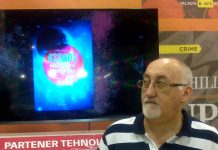The dotReader people have long set their sights on Adobe. But could another major battle be with VitalSource, which, though widely distributed software, focuses on making existing computers fit for e-reading?
VitalSource, in partnership with heavy hitters such as Lenovo/IBM, provides institutions with searchable classics installed on hard drives, among other media. And now I see that dotReader developer OSoft has demonstrated its baby on a FlashDrive. “This gizmo the size of your pinky gives you access to everything from Dickens to YouTube,” Michael Rogers writes in the LJ blog after seeing a dog-and-pony show at this week’s IDPF conference on digital reading.
Invading dotReader territory
Meanwhile, in the other direction, VitalSource is deep into dotReader territory with its own system of shared annotations and highlighting (thanks to John Mayer for the VS-related link).
As interesting as dotReader’s FlashDrive demo is, I can easily envision the more established VitalSource doing something similar if it isn’t already, just as I can see dotReader coming on a FlashDrive with public domain content. I wasn’t at the demo and am not sure if it featured an actual product, especially with preloaded books formally offered. At least as of a few minutes ago, I didn’t find an OSoft press release on the dotReader site mentioning a product, so I don’t know if the FlashDrive was just a concept demo—a come-hither for prospective commercial partners. OSoft already is working with Teachers without Borders on FlashDrive-based distribution of TWB books if past plans panned out; the technical capabilities in the software already exist. But that’s a long way from a major deal with, say, SanDisk.
Meanwhile, just as OSoft has designed its system to do, VitalSource allows purchase of e-books from within the reading system. Yet another overlap.
dotReader worth considering—but keep your eyes open for gotchas
So is dotReader worth considering? OSoft raised ethical questions when it played down OpenReader in favor of its own “standard” after I evangelized for dotReader as the first implementer of OR and even gave the software its name. So beware of proprietary gotchas despite all the talk of openness. Check into details such as the annotations formats and all the business and technical issues related to notes servers.
These days, in fact, OSoft talks about how DigitalPulp Publishing has “adopted the dotReader format and is creating a dotReader version of all their titles” (quite a change from the days when OSoft denied there was a dotReader format). I couldn’t even convince OSoft to display the OR logo on the dotReader home page despite the countless hours I devoted to calling up publishers. Bad vibes if you’re in a field like publishing or libraries and must rely on long-term trust (my real agenda was LibraryCity, which I prefer to be built around durable standards—the reason for my OpenReader activities).
Still, like VitalSource, dotReader might be of interest, just so you know it’s a tad less special than you’d think from the ballyhoo. While the system can be adopted for multiple formats, you don’t have to guess about which format is Number One on OSoft’s list.
VitalSource’s own challenges
If VitalSouce, which boasts of a “patented format,” wants to fight back against dotReader while the rival is still at the garage-startup stage, then it would do well to provide free or low-cost creation tools—ideally making it easy for ordinary users to create their own content, just as MobiPocket does through its conversion capabilities and in other ways.
Sooner or later, I suspect, Mobipocket will do shared notes and annotations—so VitalSource would do well to take action in the creation-tool department. Same as far as the PDA-software market, if VitalSource isn’t developing an app there already. dotReader has shown off a mockup of a Mobipocket-quality PDA interface (disclosure: in my OpenReader incarnation I suggested that OSoft/dotReader head off in a Mobi-territory direction and provided some design ideas for the handheld version).
The other thing VitalSource should do is to look ahead to the time when there is a format standard for real, or it could be in a lot of pain in the future. OSoft, while pushing the dotReader format right, is positioned to do the IDPF’s epub format even though, in my opinion, the company’s real heart is in its dotReader. If nothing else, remember that a universal DRM standard for e-book software doesn’t exist, and OSoft may want to use its own to bind protection-minded publishers to the dotReader format. While the programming side of OSoft genuinely hates DRM, I doubt this will interfere with the business side’s business plans if there are extra bucks to be made.
Detail: Hmm. Where’s version 1 of dotReader? In fairness to OSoft, software schedule are tricky to predict, especially for start-ups. Microsoft, although far from a start-up, is hardly an exemplary model. Still, it would be good for OSoft to update us on the situation here.
(Thanks to Robert Nagle for the LibraryJournal link.)


































As for DotReader, I have waited anxiously for quite a while for it to be released. Now that I have seen it, I think that it was more hype than substance. And why the glacial development pace? Are they just trying to string things along while they milk investers? Lone programmers, working part time, have been known to turn out better software in less time.
After all this time, the first released version isn’t functional enough to even be useful. Also, what are they programming this thing in? It’s over 13MB and not even close to feature complete! The only other ebook software that is this much of a pig is Acrobat Reader. The DotReader folks could take a few lessons from practically any of the other ebook reader programs out there.
Joseph,
– The latest release of the dotReader is 13MB pre-loaded with sample content – not a blank shell. IT is actually much smaller.
– There are no investors to milk.
– The reason the the "glacial development pace" is because we are programming it in Perl as a cross-platform, zero install program. We would have been done a long time ago if we were only programming for Windows or Linux or for a proprietary platform or device. We have also contributed over 120 modules back to the open source community that we developed. Many of them are new, cutting edge applications.
– The plug in architecture allows users to develop their own feature sets for the dotReader to meet their business development needs.
– The latest release (here)
supports the new .epub format and several .epub documents are included. The spec has still not been approved yet.
– The most recent addition is an advanced search which allows you to search your current book, select books, or the entire library.
– Currently, there is not much content in the .epub format for you to test drive.
– The dotReader is not ready for active, daily use, but the content is not ready either.
Be patient. Be kind. Provide constructive feedback on our website. Please read following post.
Mark Carey
It was an honor and privilege to present OSoft’s dotReader at the 2007 IDPF conference. Unfortunately, I ran out of time and “got the hook” and was unable to complete the demo. I appreciate the offer to tell the rest of the story here…
1. The dotReader is an open source, cross-platform, zero install program. This means it does not require installation like other applications. The fact that I ran the demo completely off a flash drive is not new – the dotReader has always been like that. What is significant is that by using a flash drive, wherever I go, my reader, books, notes, highlights, and other multi-media goes with me. Just plug and play.
2. You mentioned VitalSource in your blog. We are not directly competing with VitalSource as they use proprietary software and we are totally open source. We provide the opportunity for publishers, authors, distributors, businesses or anyone else to take the dotReader and customize it any way they wish.
3. There really is no dotReader format any longer. The initial format rendered by the dotReader was in support of OSoft’s previous ThoutReader content. We are not creating new content in that format.
4. Little known is the fact that we did not even start building the OCF plug-in until one week before the convention. Thanks to the robust architecture (and talented pool of programmers) the dotReader now supports IDPF’s .epub format – which was demonstrated at the conference. Some sample .epub books are now preloaded into the latest release. This “standard” will take some time to implement. Publishers were getting their first exposure to it at the IDPF conference. I don’t really expect full adoption until software, devices, and content falls into alignment. Of note was Sony’s comment that OCF support is in their “future plans”. Due to a family emergency, Mobi was not present to present so their plans were not publicly discussed.
5. Now that we have some experience with the OCF plug-in, we believe we could create an OpenReader plug in quite readily. The challenge is analaogous to what comes first – the chicken or the egg. According to Jon Noring, the creator of OpenReader, he is not aware of any content that has been developed in the OpenReader format except for the My Antonia demo book. At the conference, Adobe demonstrated InDesign CS3 which exports content directly into an .epub file format (which the dotReader can read). To my knowledge, no one has developed an OpenReader content creation tool yet – although there is interest by Jon to do so. I am sure your readers would agree that is does not make sense to develop an OpenReader plug in for no content and no creation tools. Once those are available, of course OSoft will support the OR format as an additional plug in. Right now, the demand seems to be for .PDF, HTML, Word, and Open Office plug ins.
6. With time running out, I had a choice. Show embedded flash and streaming Trunk Monkey video or show how the dotReader supports online/offline threaded annotations. I chose the former and ended with a bang.
7. Upcoming developments include completing the library, ad server, and customization. We are almost there folks.
Thanks for all your support.
Mark Carey
CEO, OSoft
I just wanted to add that there are several reasons for the “glacial development pace”:
1. we are building simultaneously for 3 platforms using 3 browser widgets. This means that to add certain features we have to implement the feature in 3 different classes. We are currently developing a wx::webkit module that will allow us to use the same browser widget across all platforms. This will greatly speed up development.
2. We are maintaining 75% + test coverage.
This means that to add a feature we first write unit test and then add the feature. This development process is typical in open source development where you have multiple programmers submitting patches and source code and allows.
3. Book – plug in architecture. To allow mutiple book formats we must constantly refactor out book api to support different book paradigms.
4. This is still a relatively new open source project. As the project grows and gains interest, more developers will come on board which will help speed development.
We also provide experimental preview-builds from our website. Typically we push new preview builds several times a month which I do not feel is glacial at all. Creating a build environment to allow us to push builds for all platforms has been part of the slowdown, but we felt that this was very important.
Mark, I did a presentation about ebook technologies today to an educational group. I mentioned finding the concept of the “flash drive library” to be fascinating. Not only is flash media falling in price, but plugging it into another display device solves the chicken-egg problem about SW/HW. A school district doesn’t need to commit to an unfamiliar and unproven technology and doesn’t need to invest a lot of money up front. Basically all the school needs to do is find some display device which lets you run applications from a flash drive.
Here’s what I’m wondering. Do any of the HW ebook device vendors have a USB interface for loading flash memory? what about media cards? (a pda for instance).
Robert,
Actually, they do. We are in a LOT of talks right now. I think that HW companies are FINALLY recognizing that a good open source reader compliments their open source OS (Linux). The dotReader gives them the added benefit of reading multiple formats as opposed to those limited by the Sony eReader.
Does anybody know when the Dotreader development ceased to be, and the last known release of it listed above as at became entry point to a link farm?
Sorry about the missing link above, TR’s client didn’t like the syntax. I repeat: does anybody know when the Dotreader development ceased to be, and the last known release of it listed above as at http://dotreader.com/site/dr_download/preview became entry point to a link farm?
The above short exchange with the company’s founders is the sole proof of their once-existence here at Teleread, btw.